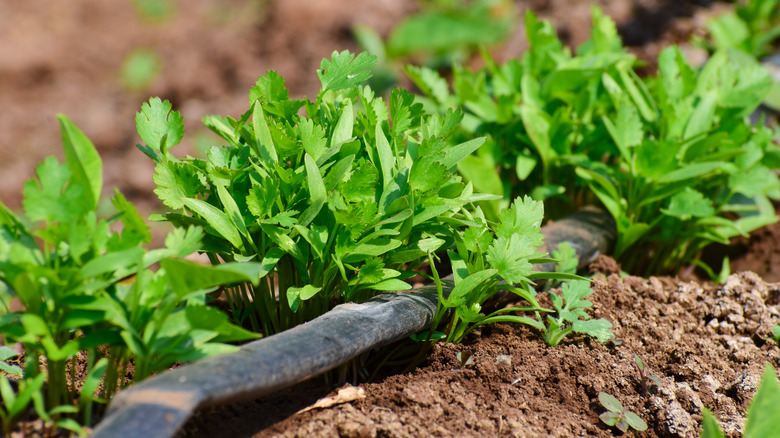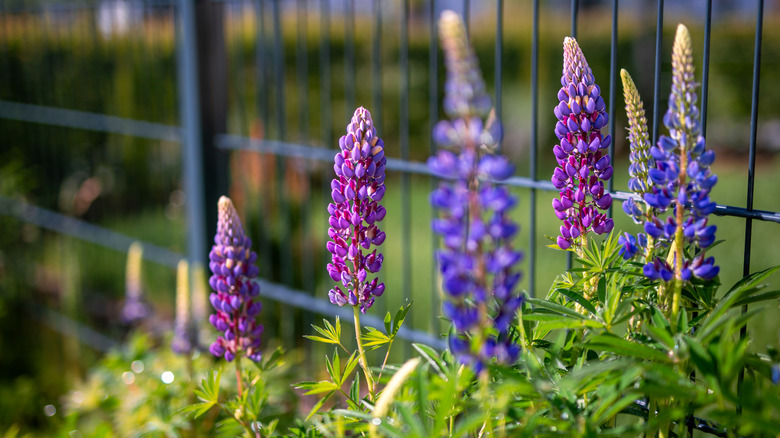The Soil-Enriching Plant You'll Want To Grow Next To Cilantro In Your Garden
Cilantro (Coriandrum sativum) is the perfect filler plant for a cottage garden and a pest-controlling potato companion for a vegetable patch. There are companion plants that can help your cilantro be healthy and tasty. One to consider is lupine (Lupinus spp.). Like sweet peas (Lathyrus spp.) and purple prairie clover (Dalea purpurea), lupines are flowering legumes that infuse nearby soil with the nitrogen cilantro needs. This nutrient helps cilantro plants develop strong, green leaves. When a cilantro plant is severely lacking in nitrogen, its foliage turns yellow.
Lupine and cilantro are easy to grow together because they will thrive in the same conditions: cool weather, full sun or partial shade, and mildly acidic soil that drains water well. These two plants also favor a similar set of growing zones. Both excel in USDA hardiness zones 3 through 8. Cilantro is suitable for zones 2, 9, 10, and 11 as well; however, it is prone to bolting in the hot weather of the higher-numbered zones. No matter where you're growing cilantro, give it some afternoon shade to help prevent this problem. When the plant bolts, its leaves take on a bitter flavor. Choosing a slow-bolting variety — in other words, one that's unlikely to make flowers when stressed — can boost your chances of success. 'Costa Rica' and 'Leisure' are two cultivars known for having this quality.
As a bonus, blooming lupines attract pollinators that can benefit nearby veggie plants, fruit trees, and herbs such as cilantro. Some types, such as the hairy lupine (Lupinus villosis), even draw songbirds that will eat problem-causing insects and stop weed seeds from sprouting in your garden.
Care tips for cilantro and lupines
The happier your lupines are, the better they'll be able to assist your cilantro. Luckily, caring for lupine plants is pretty straightforward. There are about 300 different lupine species, and each one's needs are a little different. In general, these plants prefer soil that's lightweight and contains a bit of sand to promote water drainage. Breaking up compacted soil is also important, as it encourages each lupine's taproot burrow deep into the earth, where it can deposit lots of cilantro-feeding nitrogen. Making the top foot and a half of soil nice and loose helps this long root grow strong and ensures that it gets plenty of health-supporting oxygen. Though you can plant lupine seeds in fall or early spring, the former is best if you'd like the plant's flowers to bloom in April or May.
Growing cilantro plants isn't hard, either. Like lupines, cilantro appreciates some sand in the soil surrounding it. Lupines and cilantro are both amenable to mulching since they like their soil slightly damp. Mulch can also suppress weeds that might steal cilantro's nitrogen and regulate root temperatures, especially when hot weather strikes. Just keep mulch away from the crowns of your lupines since this can lead to rot. When the top inch of the growing site gets dry, it's time to give your lupines and cilantro a drink. Avoid overwatering your garden since some types of powdery mildew thrive in wet conditions. This fungal ailment can bother cilantro as well as lupines.

